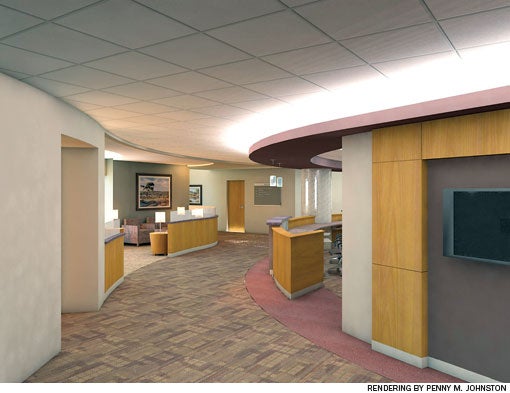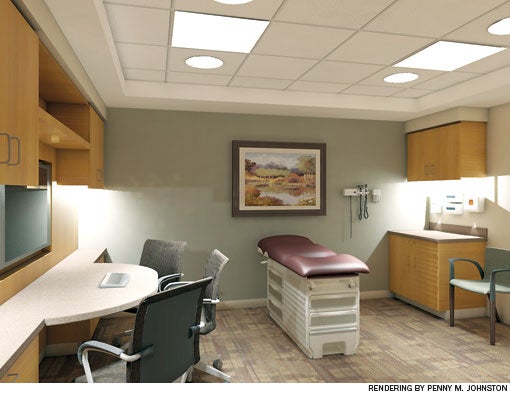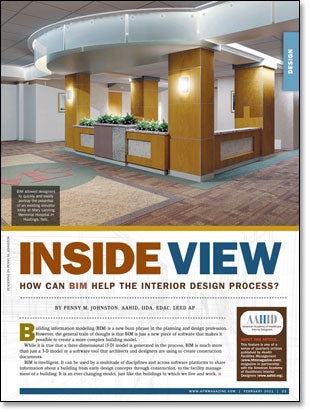Inside view
While it is true that a three-dimensional (3-D) model is generated in the process, BIM is much more than just a 3-D model or a software tool that architects and designers are using to create construction documents.
BIM is intelligent. It can be used by a multitude of disciplines and across software platforms to share information about a building from early design concepts through construction, to the facility management of a building. It is an ever-changing model, just like the buildings in which we live and work.
Design team collaboration
The traditional process of designing and constructing a building can be compared to a relay race. Every discipline is waiting for its turn to grab the baton and run with it. Along the way, batons are dropped and important information is lost. The process under BIM is more like a rowing team. All disciplines are working on the same file at the same time. Everyone is in the same boat working together with the same goal in mind — to create an efficient, easy-to-maintain building designed for healing.
According to San Rafael, Calif.-based Autodesk Inc.'s white paper on "BIM for Interior Design", the key advantages of BIM include the following:
- The speed and ease of creating an interior-design model, coupled with the ability to visualize that design;
- The ability to capture and manage the design as multiple options such as space layout and material selection within a single model; and
- The richness and reliability of the data embodied within the model.
The tools within a BIM software system make it easy to communicate ideas, analyze and evaluate the space, and give an advantage to predicting real-world performance of the finished building. A designer is able to easily study multiple design alternatives that are reflected accurately in all related schedules, views and drawings.
Planning coordination
The most significant benefit interior designers experience with BIM is the degree and ease of coordination possible among architects, engineers and interior designers. Because everything is modeled, and the models from all consultants are linked, an interior designer is able to see every electrical box and plumbing or light fixture. As an elevation of an interior wall is created, for example, the interior designer instantly can see if the electrical engineer has provided the junction box behind a base cabinet or above the countertop.
In the past, this level of coordination didn't happen until the construction documents were nearly ready to be sent out the door, and this was done by looking at two-dimensional plans. The byproduct of this coordination is a significant increase in communication among the designer, engineer and, ideally, the subcontractors in the earliest stages of design, rather than after the fact in the field.

Using BIM, the design team is able to experience the entrance to a department before the space is even built.
Key areas of concern for interior designers include the following:
Furniture and equipment. BIM is a powerful tool for placing, documenting and scheduling such items as furniture and equipment.
The ability to sort, count and filter the databases are endless and accurate. Every object placed in the model has parameters, such as model number and cost, from which the schedules pull their information. As long as the information entered into the object is accurate, the schedule will be spot-on and instantly updated every time the floor plan is modified. Designers are able to start scheduling furniture and equipment the moment the object is added into the model.
This saves significant time when the purchasing agent needs budget numbers and quantities. It can save even more time if the purchasing agent is involved with the selections as the data is being entered into the parameters of the objects. Some manufacturers are catching on quickly to the BIM movement and have started providing their products to designers already modeled with all the information needed to specify and purchase their products.
Accurate furniture and equipment counts lead to accurate schedules for those items. This, in turn, leads to minimal late changes and more precise equipment counts.
Finishes. Finishes that are modeled, such as flooring, can be tagged, scheduled, quantified and even can be put into "take-offs" while they're being selected.
If a department director decides to change the flooring patterns for an entire floor the day before the subcontractor needs to place the order, for example, the designer can instantly and accurately schedule the carpet quantities for the areas affected and tell the contractor exactly how many square feet of different types of carpet tile need to be ordered to meet the deadline.
The ability to calculate area and quantity of materials effortlessly and reliably reduces the overall project cost by producing accurate estimates and minimizing orders of excess or unnecessary materials. Accurate area measurements lead to accurate finish budgeting for items like carpet and ceiling tile.
Benefits during construction
Architects and interior designers should allow, and even encourage, contractors and suppliers access to the information in the 3-D model as soon as the contractor is a part of the team.
In an ideal world, an integrated project delivery method would be used. The open sharing of information builds trust and a sense of collaboration among team members, which can reduce time and cost to the owner.
With BIM, there is a significant reduction in change orders as well as requests for information from the contractor and their subcontractors. Because BIM is a
3-D model, there is no fudging of dimensions. In two-dimensional software packages, dimensions can be overwritten, making the completed document inaccurate and often resulting in a change order during construction. BIM software won't let designers make up numbers and enter what they think it should be. It is as it appears, and if it's modeled wrong, it must be fixed immediately.
Construction can be streamlined even more with project information management (PIM) software and electronic documentation. With PIM, submittals, requests for information, change orders and transmittals are exchanged immediately between team members with notifications arriving in everybody's inboxes.
This dramatically improves the construction administration portion of the project. For example, it allows interior designers to turn around a paint submittal the same day the contractor submits it. Other members of the construction team will see similar benefits.
BIM after construction
There is currently a convergence of opportunities brought on by technology and new business processes. With this comes a strong desire for more predictable, accurate and responsible outcomes from heath care facilities.
The accuracy and level of detail possible through BIM also segue into more effective ways of managing and operating the resulting facility. The building owner now has the ability to track occupancy, space allocation and assets.
Thus, BIM can make life much easier for facility managers. A facility management software package that utilizes the building information model easily enables the facility manager to track finishes, furniture, equipment and other assets. An old set of paper plans rolled up in a box with red lines and taped-on design modifications are in the past.
Opening up the 3-D building information model of a hospital on a computer and quickly filtering the information to generate life-safety reports is a useful facilities management tool. Likewise, by selecting a piece of furniture on the screen, the facility professional instantly can know the manufacturer, model number, warranty and contact information for replacement parts.
Moreover, if a damaged ceiling tile needs to be replaced, the exact product information is at hand. A health facility professional no longer has to search through four different project-specification books, old submittals and a set of construction documents to figure out exactly which ceiling tile is the existing product type.

BIM allows designers and potential users to quickly see such design options as the layout of casework and finishes on the floors and walls.
Room for improvement
While the advantages of BIM to the health care interior design profession are apparent, there is still a lot of room for the technology to grow into a fully functional interior design tool.
In many ways, the software doesn't translate well to what interior designers do every day and how they document a project. For example, the room finish schedules are not able to pull information from the floors, walls and ceilings. This leaves designers manually entering this information similar to how it was done
10 years ago. Unless the finish is modeled, it cannot be parametrically tagged and scheduled. When the software is able to do this, the accuracy of these schedules will be just as tight as the furniture and equipment schedules.
It is only a matter of time before these items will be worked out, however, and the job of an interior designer to document the interior finishes of a health facility becomes just as accurate and parametric as furnishings and equipment.
It is sometimes hard to know how much information needs to be modeled in BIM. It is a balancing act and with every project designers are learning and changing their processes to become more efficient and accurate.
Taking advantage of BIM

A building owner needs a team of representatives, architects, engineers, interior designers and contractors developing an accurate building information model from the very beginning of a project to take advantage of everything BIM can offer.
From the health care interior designer's perspective, BIM is helping to improve contract documentation, preconstruction estimating, procurement, scheduling, coordination, cost-efficiency and closeout documents for the finishes, furniture and equipment that are integral to the environment of care. hfm
Penny M. Johnston, AAHID, IIDA, EDAC, LEED AP, is an interior designer at Visions in Architecture, Lincoln, Neb. She can be reached at penny.johnston@viarchitecture.com.
Sidebar - BIM helps design team achieve goals





